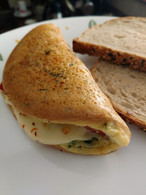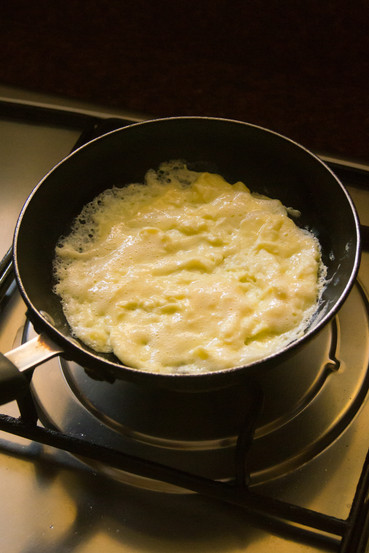

Say 'breakfast'
and my mind hits the buzzer with 'eggs!'
I'm not exaggerating when I say I LOVE eggs. I love eggs. I love that they are so versatile. I love that it's such a humble ingredient, one that just needs a little tender loving care to make it shine.
As the year goes by my preference for how I like my eggs cooked goes on changing. At the start of this year I was all about poached eggs; these past couple of months have been all about the perfect soft boiled egg, and lately a lot of sunny sides up.
Based on my interpretation, I classify preparing eggs into two categories: Whisked and Whole.

This blog post will focus on some whisk and cook egg techniques. I in no way guarantee these to be the best or most refined techniques, but this is just what I've learnt so far and found to suit my style the best.
WHISKED
Crack an egg, whisk, cook, and serve. Not very technical and there are a million different ways people do it. With whisked eggs, you want them to have a soft, velvety texture. No one said it better than the king of home-cooking, Jamie Oliver —
"Cooked in the pan, overcooked on your plate."
I cannot exaggerate the importance of this enough. Eggs are pretty quick to cook and they can go from being perfect to overcooked in a matter of seconds. So when they are still a bit runny and almost close to done, that's when you need to take them off the heat and onto your plate. The residual heat will continue to cook the eggs and they'll be melt-in-your-mouth delicious when you eat them!
Scrambled


You can't really mess up a scramble, because it's already a mess. But if you're looking to make a glorious mess, follow these simple tricks to make the most creamy, velvety scrambled eggs:
Richness boost #1 : Cook in butter. Heat up a non stick pan on medium heat, add a generous knob of butter to it.
Richness boost #2: Milk/cream. Crack an egg in a bowl and add a dash of milk/cream to it (about a teaspoon for each egg). Season with salt and whisk well. Bubbles are good; you'll have a lighter texture.
Texture Boost: Once the butter is foaming, pour in your whisked egg. Turn down the heat to low. Do not start stirring immediately; let it sit for 10 seconds. Using a spatula, lightly start pulling in the egg from the outer edge of the pan to the centre. Repeat until all the runny egg is set. This is your ticket to a velvety scrambled egg. When the scramble still looks a little wet, but has come together, turn off the heat and let it sit in the pan for 10 seconds, then serve. Crack on some fresh black pepper and find your way to buttery scrambled egg heaven!
This scrambled egg may seem like a basic one, but it's out there with the Forbes richest. Want to make it even more loaded? Grate in some cheese, or boost up the aroma with some herbs like coriander, parsley or thyme.
Check out my recipe for homestyle Masala Bhurji for an Indian variation of the scrambled egg.
Omelette:
The scrambled egg that has got it's life together — a.k.a an omelette.
I use two different techniques to ensure a fluffy texture —
Technique #1: Your everyday Fluff (also known as an American Omelette):
Heat up a non-stick pan on medium heat. Crack a couple of eggs in a bowl and add a dash of whole milk/cream (about 1 tbsp for 2 eggs). Season with salt and whisk together.
Add a knob of butter to the pan and once melted, pour in your egg. Using a spatula begin to move the cooked egg from the edges, towards the centre. Swirl the pan to coat the pan evenly with uncooked egg. Continue until there is no runny egg left. Even out the eggs, turn off the heat and cover. Rest for 30 seconds. Fold and serve immediately.
The simple trick of lightly, but not fully, scrambling the eggs yields a fluffy, rather than flat, omelette. It works well when you've added vegetables and herbs into your eggs and still want a light structure.
One of my favourite ways to have an omelette is just like my mother makes it, by adding finely chopped onion, tomatoes, green chillies and coriander into the mix. Served hot with a little ketchup smeared on it, and some warm brun paav (crusty bread), it's a household favourite.
Technique #2: Super Fluff
On days when I want to have not just a regular omelette, I like to make what I call the 'soufflé omelette'. It takes a little extra effort to whip up the eggs, but it's worth the muscle exertion. Whisk the eggs until they are more than doubled in volume (they will turn pale yellow) and there's no runny egg left. You can use an electric whisk for this.
Heat up a pan on medium heat. Melt in a knob of butter.
Turn the heat down to low and pour in the whisked eggs. Let cook for 30 seconds, then using a spatula lightly pull in the cooked egg from the outer edges to the centre; even it out with uncooked eggs.. Repeat this process only a couple of times. You want to give the omelette some sturdiness, not completely deflate it.
Cover and cook for 2 minutes. Do not lift the lid in between.
Turn off the heat after two minutes (you can grate over some cheese at this stage if you'd like) and rest for 30 seconds. Fold in half, and serve immediately.
I hope these techniques help you level up your breakfast game. Do share your experience if you try out any of these. Feedback is much appreciated. :)
Now it's time to scramble, but do come back next week for part 2 on more eggcellent tips and tricks!
.png)

























